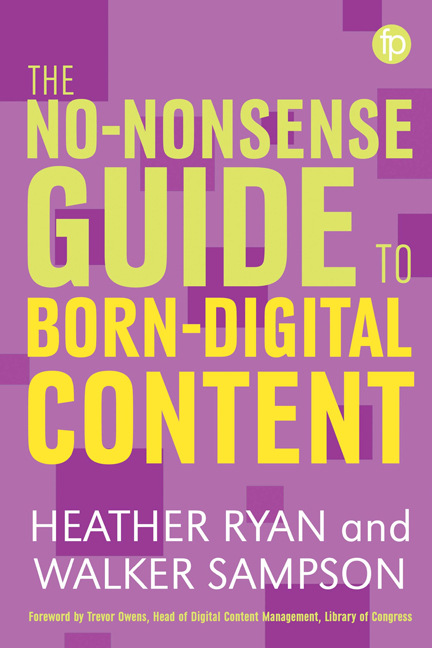Book contents
- Frontmatter
- Contents
- List of figures and tables
- Foreword
- Acknowledgements
- List of abbreviations
- Glossary
- Introduction
- 1 Digital information basics
- 2 Selection
- 3 Acquisition, accessioning and ingest
- 4 Description
- 5 Digital preservation storage and strategies
- 6 Access
- 7 Designing and implementing workflows
- 8 New and emerging areas in born-digital materials
- Conclusion
- References
- Appendix A Resources
- Appendix B Basic Unix command line prompts
- Index
Conclusion
Published online by Cambridge University Press: 08 June 2018
- Frontmatter
- Contents
- List of figures and tables
- Foreword
- Acknowledgements
- List of abbreviations
- Glossary
- Introduction
- 1 Digital information basics
- 2 Selection
- 3 Acquisition, accessioning and ingest
- 4 Description
- 5 Digital preservation storage and strategies
- 6 Access
- 7 Designing and implementing workflows
- 8 New and emerging areas in born-digital materials
- Conclusion
- References
- Appendix A Resources
- Appendix B Basic Unix command line prompts
- Index
Summary
The best of my nature reveals itself in play, and play is sacred.
(Karen Blixen, On Modern Marriage and Other Observations, 1987, 80)Now that you've made your way through the book we hope that you feel confident enough to embark on some born-digital content management, and to start the long and exciting journey of learning and growing as the technology we use to record knowledge shifts and changes over time. Now that we've whetted your appetite, we encourage you to take a look at the additional resources in Appendix A for more avenues to explore. We wholeheartedly encourage you to pick up more computer programming skills if that's a path that interests you. If it doesn't, that's fine too.
The fact that you picked up this book indicates you have at least an interest in the subject, which is half the battle. We want to emphasise that having strong computer programming and technological skills is not imperative in order to be a good born-digital content manager. You need to have the basic knowledge of the challenge, to find the right people who can help you and to communicate with them what you need to happen and why. We hope that we have shared with you enough of the fundamental knowledge you will need in order to do this and to guide you in the direction of more information that you can pick up as you go.
After reading this book you should know a little bit more about the basics of how digital information is created and rendered, and about borndigital-specific practices around selection, acquisition, description, preservation and access – how to tie all of these elements together; and a little bit about what may lie ahead.
In Chapter 1 you learned about the range of methods by which words, numbers, images, sound and videos are encoded into the binary information that computers are designed to interpret and render in various ways. We considered a number of different digital file formats and looked closely at how binary information is encoded on different types of physical media. In that chapter we also introduced some basic information about the command line and how you might use it in your practice.
- Type
- Chapter
- Information
- The No-nonsense Guide to Born-digital Content , pp. 177 - 182Publisher: FacetPrint publication year: 2018



